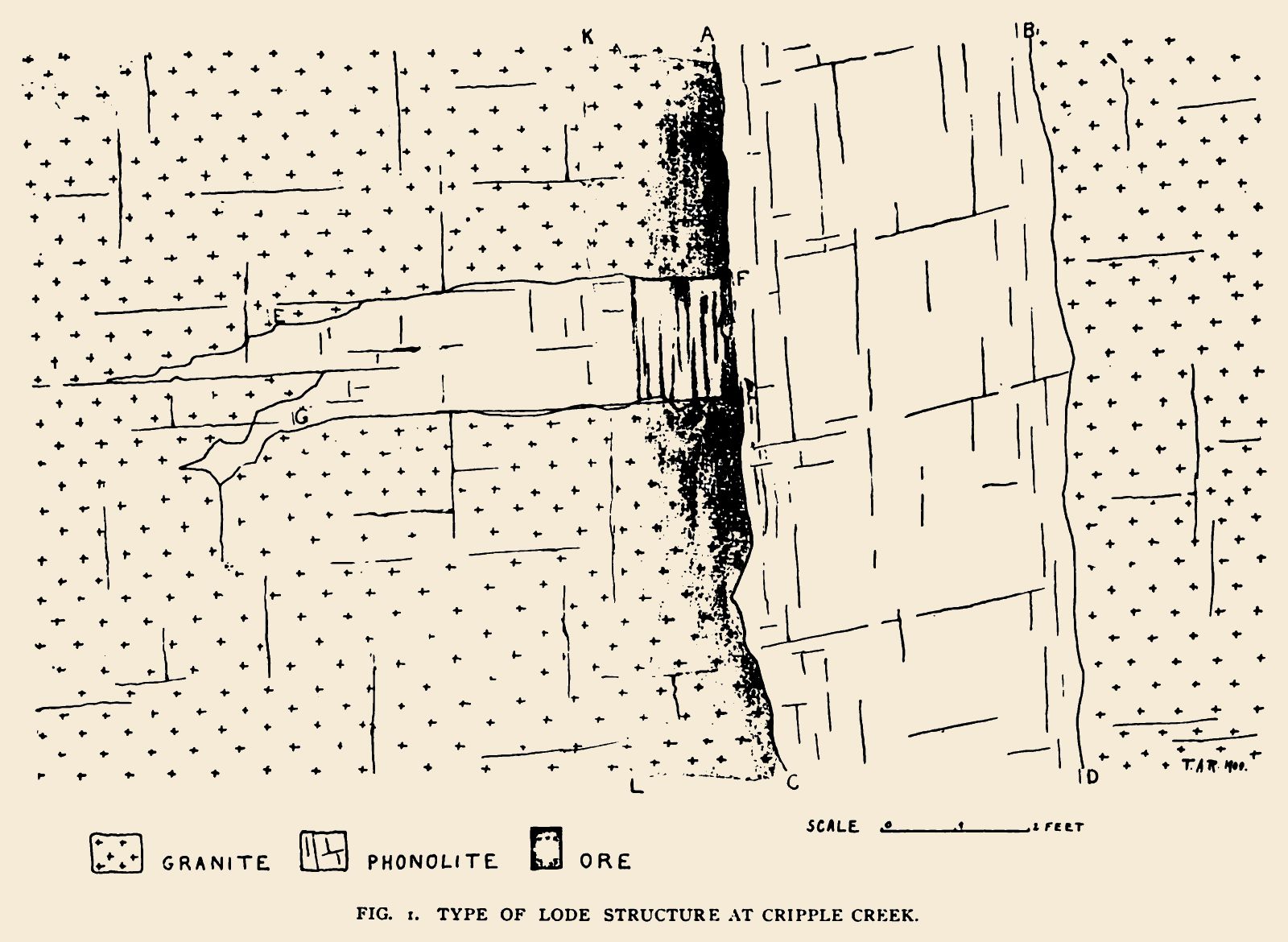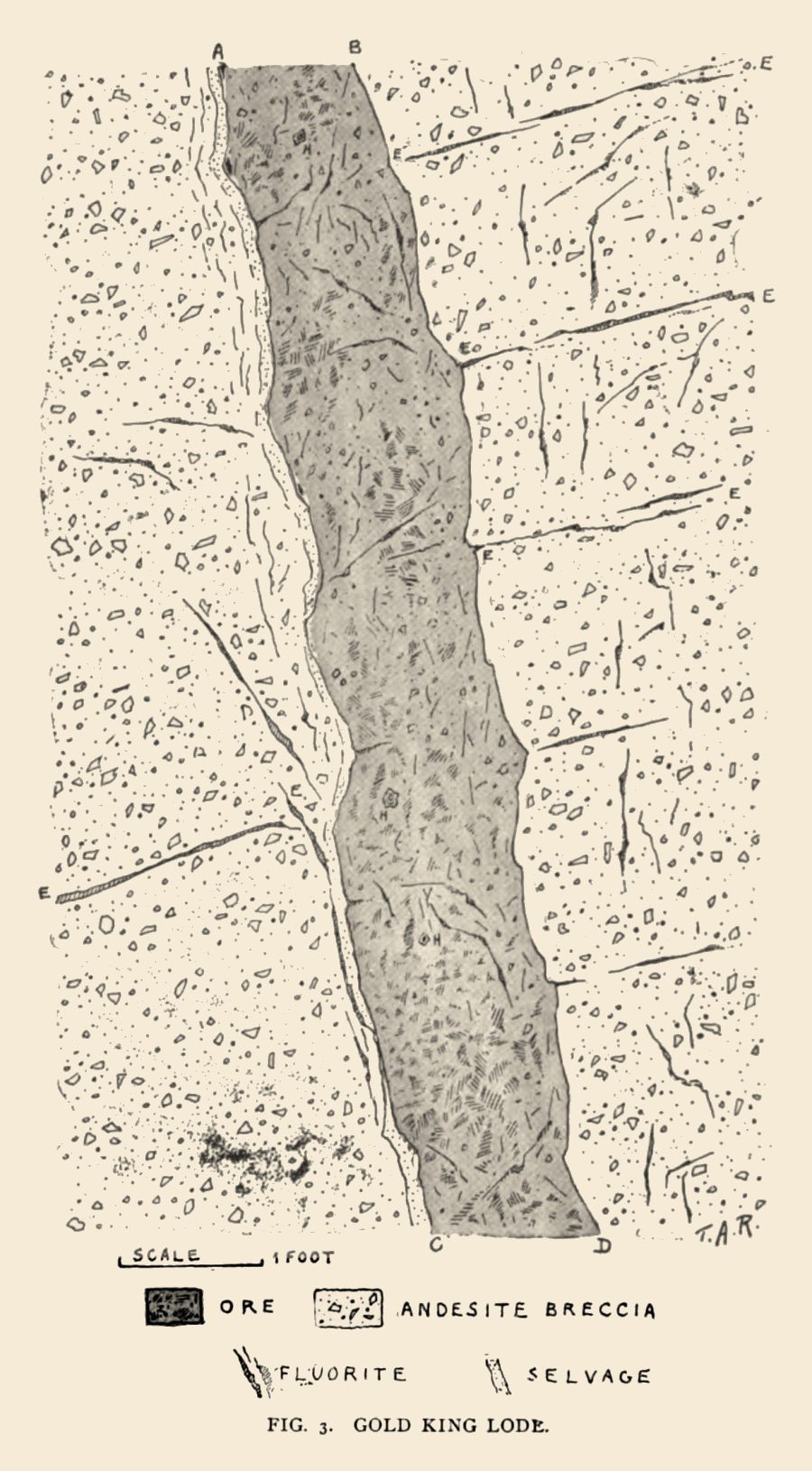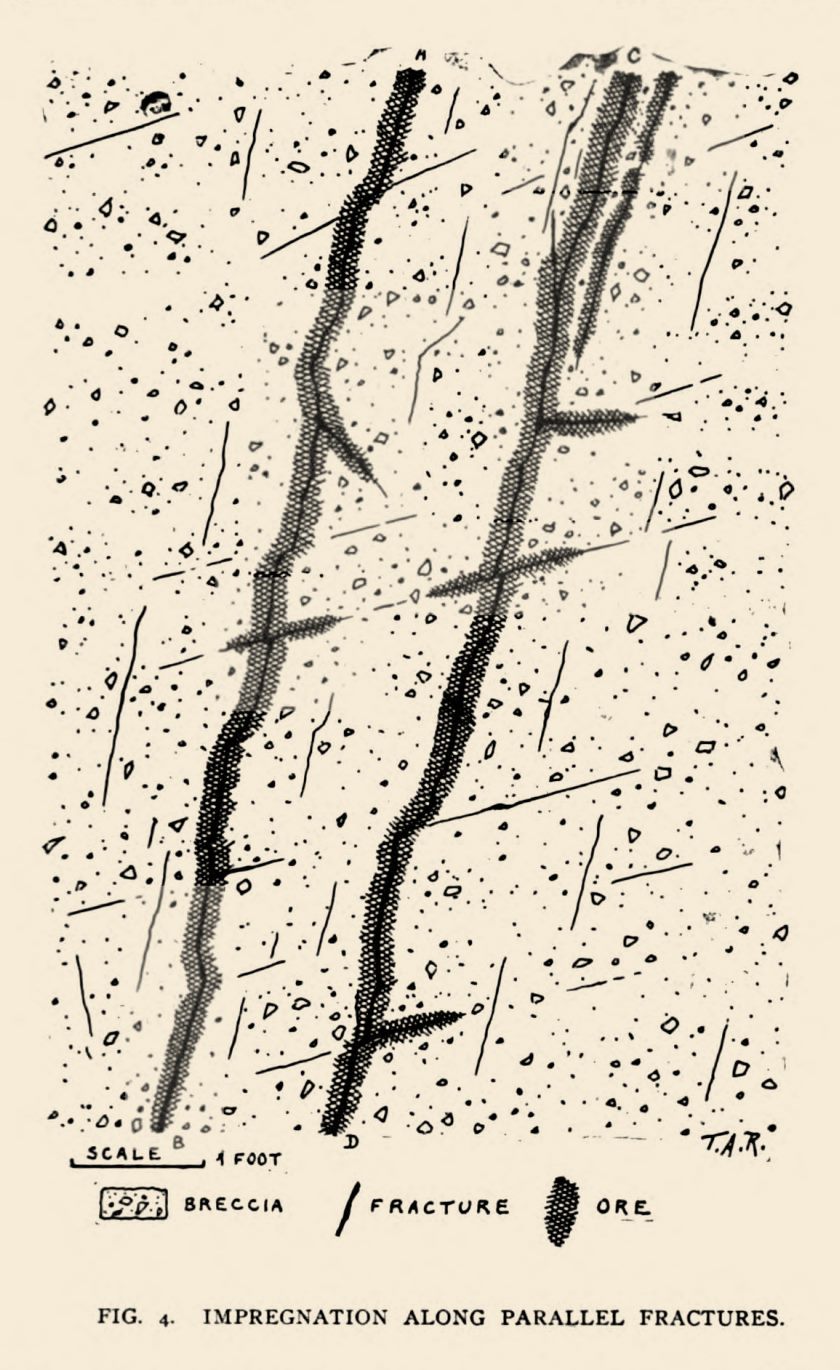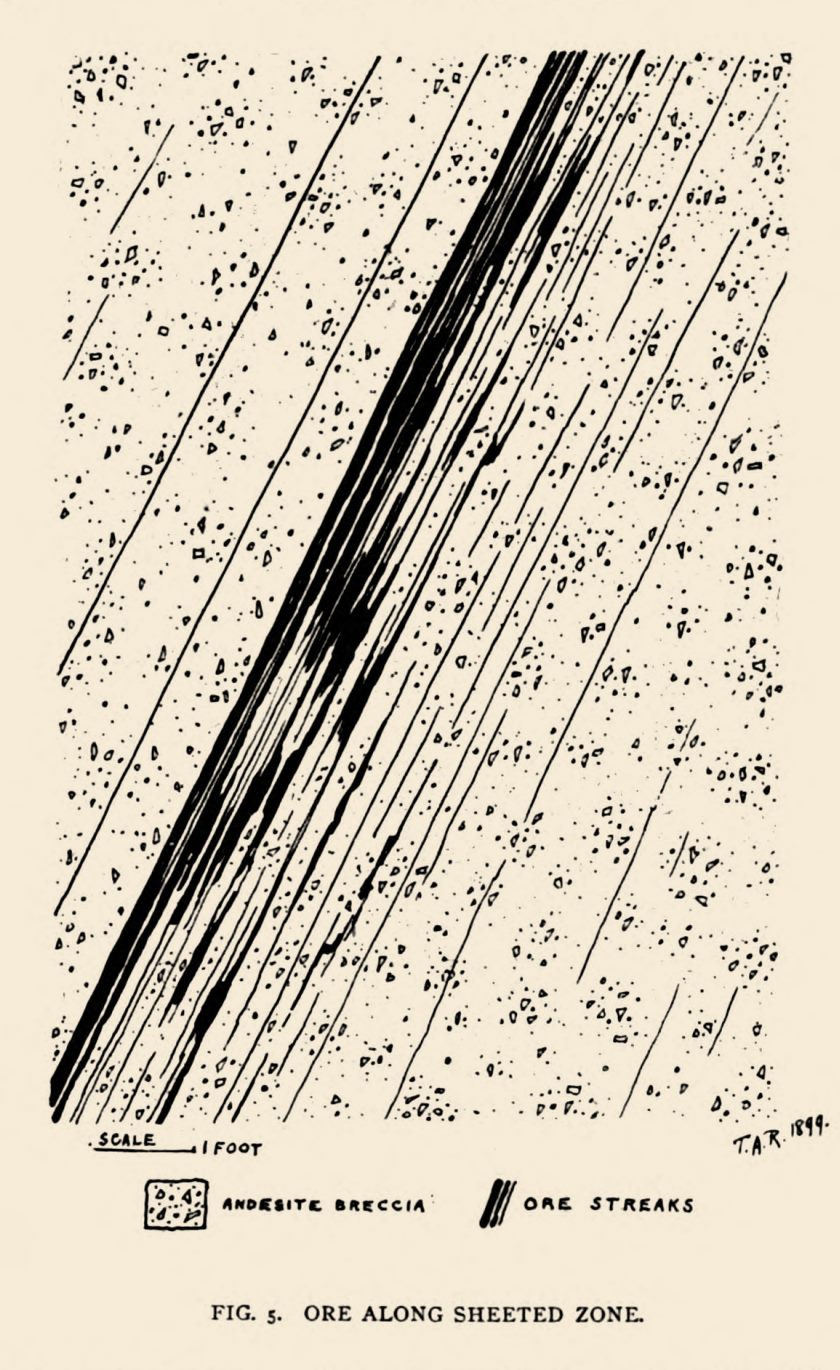-> My Collection; No source to show as I've not scanned the Mining Journal as an album.
But, here is a link to the first page on the Hathi Trust Digital Library website.
January 31, 1903 (pages 179->181)
Abstracted from a paper read before the American Institute of Mining Engineers, at the New Haven meeting, October, 1902
A small section of a single vein will sometimes typify the lode-structure of an entire region. Such, I believe to be the case in the occurrence which is illustrated in Fig. 1.
The scale indicates that the space covered is about 10 feet high by 16 feet wide. The country is the pink, coarsely crystalline Pike's Peak granite; the vein, A K, L C, appears as a band of iron-stained, decomposed granite alongside of a phonolite dike, A B, C D, which throws out a nearly horizontal tongue, E F, G H, into the country on the west. This off-shoot from the dike is crossed by the vein, and it affects the distribution of the ore.
Thus, while the decomposed gold-bearing granite, constituting the lode, is about 1½ feet wide, both above and below this intrusion of phonolite, it is broken up at the place of crossing into a few stringers cutting through the phonolite, so that while the lode maintains its continuity it does so with difficulty.
An important feature of the section is the evidence obtainable as to the relative age of the phonolite and the joint-planes in the granite. The phonolite is, of course, younger than the granite which it penetrates, but this is not all. It is also apparent that the joints in the granite are more recent than the dike. Observe how the joint-planes, E F and G H, cut through the protruding sinuosities of the outer edge of the phonolite.
It remains to add that there is a distinct division, but no selvage, between the hanging wall, A C, of the vein and the dike which it accompanies, while on the other side, K L, the vein is not marked by any clear line, but graduates, by the lessening of the evidences of decomposition, into the outer granite. The east wall, B D, of the dike exhibits a marked selvage, and it is also accompanied by traces of ore. On the joint-plane, G H, which is nearly horizontal, there is a slight but evident selvage.
The story told by this section is that the phonolite penetrated the granite, that subsequently a line of fracture was established alongside the phonolite, that this afforded a passageway for ore-bearing solutions, that the impregnation of ore was less where the solutions passed through the protruding tongue of phonolite, because there the rock being closer grained and more fissile than the granite, it was broken by a very few decided cracks rather than by an irregular multiple fracturing such as determined the diffused mineralization constituting the lode in the granite; further, it is evident that the jointing of the granite, due to a condition of strain, must have occurred subsequent to the intrusion of the phonolite, because the joints cut through the edges of the phonolite.*1
1 Of course it is possible that the cracks through the phonolite are merely the prolongation of the joints and that this extension of the latter may have been of later origin; but this is not my interpretation of the evidence as I have seen it.
Finally, it is rendered very probable that the jointing of the granite and the fracturing now identified with the lode were contemporaneous, both being the result of mechanical stresses connected with the earth-movements which followed the last stages of volcanic activity in the district.
The foregoing example will serve as a text for a general statement. The lodes of Cripple Creek are essentially lines of fracture accompanied by a variable width of rock, the constituents of which have undergone replacement by fluorite, quartz, pyrite and other gangue, together with gold-bearing tellurides. The width and distribution of the ore depends upon the extent and character of the fracturing; the study of the latter is therefore of vital importance to the miner. Owing to the number of volcanic rocks occurring in the district, the veins differ greatly in appearance; but this difference is traceable to diverse structural conditions rather than to diversity of origin.
In all the lodes which I have examined the ore is essentially rock in place, however much altered; the lodes are to be regarded as bands of replacement, rather than the filling of open fissures or crevices; nor is there any departure from the rule that the lodes were formed during a late period in geological history, for the ore is, in every case, as far as I know, subsequent to the intrusion of the eruptives which penetrate the breccia, itself of late Eocene or early Miocene age.
While, these eruptives cut across each other and thereby indicate their relative succession in geological time, they do not appear to cut across the ore-veins, which, on the contrary, pursue their course amid varying petrographic conditions, unchecked but not unchanging, for to the changes due to this variable rock environment we owe the extremely interesting differences in ore-occurrence.
The lodes have originated from lines of fracture formed subsequent to all the members of that volcanic complex which constitutes the gold-field. These fractures are the outward manifestation of lines of weakness, or of such comparative weakness as is the equivalent of least resistance; therefore, it is not at all surprising that the veins frequently follow the planes of contact between rocks which are unlike in hardness, and especially the very close-grained eruptives when these traverse the coarse-textured breccia.
For this reason phonolite is closely related to the occurrence of ore, so much so, indeed, as to be often confounded with the origin of that ore. The later dikes of basalt are also notably connected with important lodes. It is possible to generalize further and state that the dikes, especially the very numerous dikes of phonolite, spread outward toward the edges of the volcanic area and, as a consequence, the strike of the principal veins also has a radiated distribution.
The latter are dependent in their strike upon structural relations coincident with the dike system, the arrangement of which points to the approximate position of the volcanic vent, or vents, supposed to be situated somewhere in the central portion of the district.
From these preliminary considerations it is evident that the study of the district, from the point of view of the miner, resolves itself into the endeavor to understand the structural relations of the ore-deposits as affected by the fracturing of the rocks.
Questions of origin may be of greater general interest, but they do not have any direct bearing on the economics of mining. To those who conduct mining operations it is not so much a question of "Where did the gold come from?" as "What are the conditions which determine the distribution of it among the rocks now penetrated by mine workings?"
Therefore, the patient deciphering of complicated systems of fracture will be of more immediate help to the miner than the broad philosophic considerations which render the science of ore-deposits so fascinating to all of those who are interested, even indirectly, in mining.
Fig. 2 is a photograph of the Anaconda lode as seen in an open-cut in July, 1897. The lode at this place forms a part of an andesite dike traversing the breccia. The dike exhibits a multiplication of fractures parallel to its walls, and along these lines of cleavage there occur seams of quartz and fluorite carrying tellurides.*2
2 The general characteristics of the ores of this district have been separately described. "The telluride ores of Cripple Creek and Kalgoorlie," by T. A. Rickard, Transactions, XXX, 708-718.
In the surface workings, the gold liberated from the tellurides occurred pseudomorphic after sylvanite*3, distributed in yellow patches amid purple fluorite, affording specimens of great beauty.
3 Sylvanite is named after the historic mining region of Transylvania, where it was first found. Owing to the peculiar arrangement adopted by the crystals of this mineral, which is such as to resemble Arabic lettering, it is also called "graphic tellurium."
An early analysis of sylvanite from Cripple Creek, made by Mr. Richard Pearce, gave Gold 25-45, Tellurium 60.61 and Silver 13.94 per cent.
When, as happens rarely at Cripple Creek, the lode consists of massive ore, notably separated from its encasing rock, it will be found that such definition of structure is due to the presence of fluorite and secondary quartz which have so filled up the interstices of the decomposed breccia as quite to obscure its original character.*4
4 See "Further Notes on Cripple Creek Ores," by Richard Pearce, Proceedings, Colorado Scientific Society, Vol. V, pp. 15-18.
Fig. 3 represents the main lode of the Gold King Mine, in Poverty Gulch. At the time the drawing was made the stopes had a maximum width of 12 to 18 feet. The rock, owing to partial oxidation, seemed at first glance to be structureless and homogeneous, but on closer investigation, prompted by contradictory assays, it was found that in the middle of the section afforded by the stopes, which were (fortunately for the purpose of observation) unencumbered with timbering, there was to be seen a compact dark band, A B—C D, from which small seams, E E, went out, almost at right angles, into the surrounding breccia. This band, which was the vein proper, also consisted of breccia, but so impregnated with purple fluorite and so interpenetrated by secondary quartz as to hide the fact.
Throughout the massive vein-stuff fine iron pyrite was scattered, and with the pyrite were crystals of calaverite, rendering it very rich. At intervals, small cavities lined with crystalline quartz occurred, as is indicated at H, H, in Fig. 3.
In these cavities occurred crystals of native gold pseudomorphic after calaverite. Owing to their dull rusty exterior they looked like bits of rotten wood, and it required close observation, especially underground, to detect them. When scratched they gave instant testimony of their precious nature.
Minute stringers of ore, rendered noticeable by the color of the fluorite, followed the cross-fractures or joints in the surrounding breccia, and, as delicate threads, accompanied the central vein, A B—C D, the boundaries of which were further marked by a granular selvage along A C.
Fig. 4 is very characteristic of Cripple Creek veins in breccia. It represents the breast of a level following one of the branches of the Bobtail lode, in the Independence Mine, on Battle Mountain. The Bobtail lode itself is similar, but its true structure is less evident on account of a more diffused impregnation of ore. The oxidation of the pyrite, accompanying gold-bearing tellurides, marks the course of the ore-streaks A B and C D. They look, at a distance, like mere stains; but closer observation discloses the fact that they are partings, along the lines of fracture in the breccia, each of which forms the center of a narrow band of oxidized pyrite and very minute, bright, specks of calaverite.
The latter is seen, under the magnifying glass, to be in process of decomposition, the oxidation of the tellurium of the telluride in the presence of decomposing pyrite having resulted in the formation of the tellurite of iron*5 and the liberation of the gold in a brown amorphous condition, resembling yellow paint which has become tarnished.
5 This alteration product has a definite chemical composition, has been determined by F. C. Knight. See "A suspected new mineral from Cripple Creek." Proceedings of the Colorado Scientific Society, Vol. V, pp. 66-71, October 1st, 1894.
Mr. Knight's analysis gave a percentage of Fe2 O3, 32.72; Te O2, 65-45; and H2 O, 1.83.
The physical characteristics ascertain were, a light brown color. A dull luster, a brilliant and uneven fracture. A hardness between 3 and 4, and a bright yellow streak.
The tributary streaks, along the cross-joints of the breccia, are also gold-bearing for a short distance away from A B and C D.
Such parallel partings as have been shown in Fig. 4 are sometimes so multiplied as to become zones of sheeting. An example is exhibited in Fig. 5. which represents a lode in the Moon-Anchor Mine. This type of ore-occurrence is thoroughly characteristic of the mines in that part of the district known as Gold Hill.
The breccia is fine-grained. The partings are about a quarter of an inch apart. They are followed by minute seams of red gritty clay, in which the tellurides can be distinguished. The individual seams are united by transverse impregnations, which collectively make a pocket or small body of ore, in which it is not unusual to encounter patches consisting of an almost solid aggregate of crystalline calaverite and krennerite.*6
6 Krennerite is a telluride of gold, approximating calaverite as regards composition, but differing from the latter in possessing a perfect cleavage. It is named after Professor J. A. Krenner, of Buda-Pesth.
This sheeted structure dies out into the enclosing country by the process of a gradual widening of the space intervening between each successive parting.
The breccia and tuff exhibit the effects of the thermal waters, which have penetrated them during the quiescent stage of the volcano. Kaolinization of the feldspars was the most evident result; the dark silicates also are entirely gone and are replaced by white mica.*7
7 As observed both by Lindgren and by Cross.
During the subsequent period, when the ore-deposits were in process of formation, these decomposed fragmentary rocks, already partially cemented by their kaolinization, became further consolidated by siliceous solutions, so as to be changed into a compact hard rock. Underground, near the veins, by reason of the bleaching, due to decomposition, the breccia has the mottled look which the miners recognize by the term "porphyry."
As in the case of the granite, secondary minerals are readily found wherever the breccia has been changed into ore and the groundmass of the rock is seen to have undergone substitution by fluorite and pyrite. The former enters into the groundmass so thoroughly, sometimes, as to make it a purple rock spotted with bits of bleached andesite.
It is a feature of the breccia that the groundmass of it has undergone mineralization more extensively than the rock fragments which it contains, an observation which illustrates the selective action of the circulating waters. As a consequence, even when it is changed into ore, the included pieces of andesite are conspicuous and are often edged with the ore-forming minerals, such as pyrite, fluorite and the tellurides. However, the most important change which the breccia has undergone, in the vicinity of the lode-fractures, is its silicification by impregnation with quartz.
This is not so apparent as would be imagined, because it does not occur in the form of bands of white quartz or dark hornstone, but rather as an ill-defined width following the dominant lines of fracture. For this reason the ore is often harder than the country, and the workings on the lode require less timbering than the cross-cuts.




